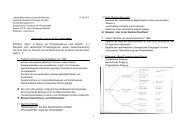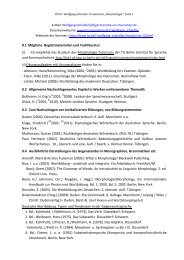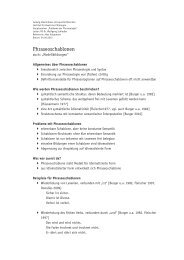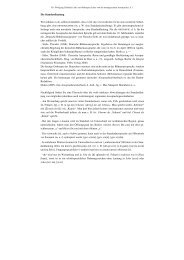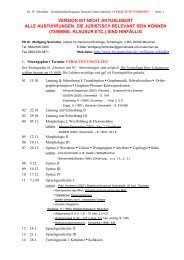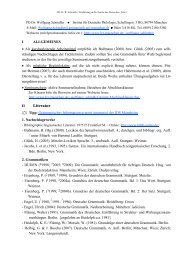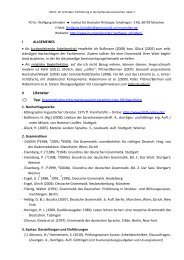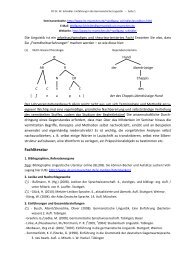Chapter 18 Lexical Functions: Description of Lexical Relations in a ...
Chapter 18 Lexical Functions: Description of Lexical Relations in a ...
Chapter 18 Lexical Functions: Description of Lexical Relations in a ...
You also want an ePaper? Increase the reach of your titles
YUMPU automatically turns print PDFs into web optimized ePapers that Google loves.
—<strong>Chapter</strong> <strong>18</strong>. <strong>Lexical</strong> <strong>Functions</strong>— 59<br />
the <strong>in</strong>herent DSyntAs <strong>of</strong> L are all shifted, or permuted, with respect to the <strong>in</strong>itial SemAs. One can<br />
easily see this <strong>in</strong> the most trivial example <strong>of</strong> the regular causative construction <strong>in</strong> French, where<br />
the <strong>in</strong>herent DSyntA I becomes the DSyntA III <strong>of</strong> the causative verbal expression:<br />
(4) Jean [= I] mange la soupe [= II]<br />
John eats the soup<br />
vs.<br />
La mère [= I] fait manger la soupe [= II] à Jean [= III].<br />
The mother makes eat the soup to John<br />
The permutation <strong>of</strong> DSyntAs entailed by a causation LF is represented by means <strong>of</strong> the<br />
empty verbal LFs, i.e., the support verbs Oper i, Func i and Labor ij. (In other words, we use com-<br />
plex LFs <strong>of</strong> the type CausOper i, LiquFunc i, etc.) In order to show more clearly the systematic<br />
character <strong>of</strong> this permutation, I will analyze an example <strong>in</strong> detail: the French noun ENVIE (desire<br />
caused by a necessity). ENVIE has two DSyntAs: I is the Experiencer and II, the Object [<strong>of</strong> the<br />
desire], as <strong>in</strong> (5):<br />
(5) Pierre [I] a [Oper 1] ENVIE d’y aller [II].<br />
Peter has desire to go there<br />
Sentence (5) can be embedded <strong>in</strong> a causative expression, as, e.g., <strong>in</strong> (6):<br />
(6) a. Cette aventure a privé Pierre de l’ENVIE d’y aller.<br />
This adventure has deprived Peter <strong>of</strong> the desire to go there<br />
b. Cette aventure a ôté à Pierre l’ENVIE d’y aller.<br />
This adventure has taken from Peter the desire to go there<br />
These two sentences are equivalent <strong>in</strong> their propositional content, and the verbs PRIVER (deprive)<br />
et ÔTER (take from) are <strong>of</strong> course values <strong>of</strong> LFs <strong>of</strong> ENVIE. Now, what should be their symbolic<br />
description <strong>in</strong> terms <strong>of</strong> LFs?<br />
Semantically, both verbs mean the same th<strong>in</strong>g: (cause the non-existence [<strong>of</strong> Peter’s desire to<br />
go there]); this mean<strong>in</strong>g has to be described by the LF Liqu.<br />
Syntactically, however, the two verbs differ by their government; to express this difference,<br />
we need the support verb LFs—Oper i, Func i or Labor ij. More precisely, priver Pierre de l’envie<br />
d’y aller is <strong>in</strong>terpreted as (cause that Peter has no more desire); s<strong>in</strong>ce a [= (has), AVOIR] is Oper 1<br />
<strong>of</strong> ENVIE, priver is written as LiquOper 1(envie). In its turn, ôter à Pierre l’envie d’y aller is<br />
<strong>in</strong>terpreted as (cause that the desire is no more with Peter); est à [= (is with), ÊTRE à] is Func 1 <strong>of</strong><br />
ENVIE, <strong>18</strong> so that ôter is written as LiquFunc 1(envie). Similarly, <strong>in</strong> the collocation plunge Susan<br />
<strong>in</strong>to a rage, the verb PLUNGE is CausOper 1(rage), while the verb OPEN <strong>in</strong> open a new perspective<br />
for him is CausFunc 1(perspective). Here are a few more examples:


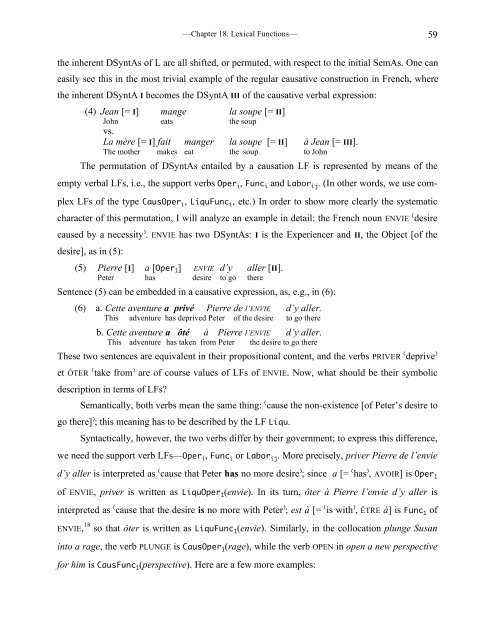
![E-Mail: Wolfgang.Schindler[ätt]germanistik.uni-muenchen.de Web ...](https://img.yumpu.com/51590147/1/184x260/e-mail-wolfgangschindlerattgermanistikuni-muenchende-web-.jpg?quality=85)
